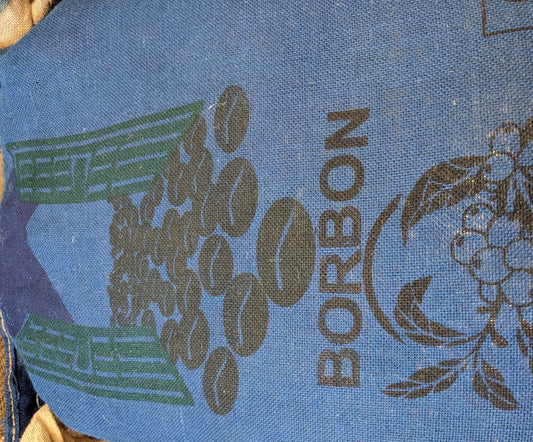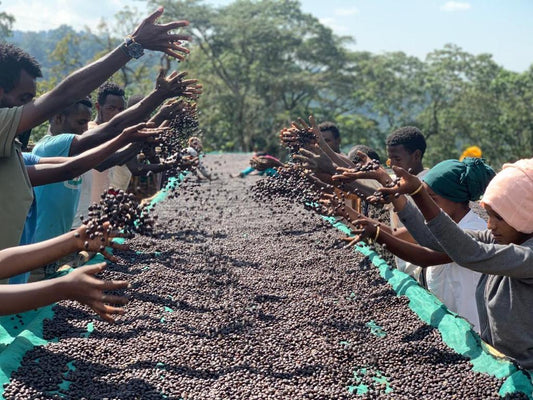So you got a little carried away on your coffee orders, huh? We've all been there. Some of us even live there.
No worries.
Today, we're going to dig into the best way to store your coffee so it stays fresher for longer.
Because maximum freshness = maximum flavour = maximum happy times.
The secret to keeping coffee fresh for longer. What the science says.
I always seem to end up with a bit of a coffee oversupply. I just can't go past a good bag.
Like a kid in a sweet shop, as soon as I read a great set of flavour notes or see an unusual origin or varietal, I'm already half way to checkout, wallet in hand.
So figuring out the best way to store coffee beans to keep them fresher for longer, fast became a priority.
Let's do the quick answer first, and then we can dive into the science a bit more.
The best way we've found to store coffee beans and keep them fresher for longer, is in their sealed and flushed bags, in the freezer, with some tape over the one way valve and away from anything else with strong odour. The less you take them in and out or open and close the sealed bag, the better.
The 4 enemies of freshness: air, moisture, heat and light.
We all know that freshly roasted, freshly ground coffee tastes better.
As coffee ages, it's these 4 things that chip away at its freshness in different ways.
Enemy #1. Air.
Air, or more specifically, oxygen, is freshness enemy number 1.
There's two reasons for that.
1. Oxidization causes the loss of volatile aromatic compounds
As oxygen reacts with the coffee, these volatile compounds that are so important for aroma, start to escape into the atmosphere and are lost.
We covered this in detail in our article on why freshly ground coffee is better than pre ground coffee.
2. Oxygen rancidifies coffee oils over time
Over time, the oils that are naturally present on the roasted coffee beans' surface, react with oxygen and turn rancid.
This is more of a problem the darker the roast, as more oils are pulled out of the coffee and onto its surface where the oxygen can get to them. But it's still an issue for relatively light roasts too over a long enough length of time.
Those oils are great for giving coffee body, but once they start to turn rancid, things go down hill pretty quickly for the coffee in terms of flavour.
Enemy #2. Moisture.
Let's talk about moisture for a second.
When specialty coffee roasters like us buy raw green coffees, they typically have between 10-12% moisture content.
Freshly picked and unprocessed coffee seeds will be somewhere in the region of 45% - 55% moisture. So farmers and producers do a lot of work to dry out the coffee seeds and bring their moisture content down to the 10-12% target range.
We need to keep some moisture in the bean, as it's important for the roasting process.
When we roast coffees, one of the many different things that's taking place inside the roaster, is that the remaining 10-12% moisture content is being evaporated away by the application of rapid heat.
But before that happens, the water plays an important role.
Water is a great conductor of heat.
So the right amount of moisture present in the green coffee, helps the heat to transfer and penetrate throughout the whole bean.
Once the coffee is roasted, it's typically then sitting at a moisture content of less than 2%.
For context... our coffees are usually roasted on the lighter side, so we lose between 11% - 13% and occasionally up to 14% of weight during roasting, with much of this being water.
If the moisture content was too low, the roast would come out uneven and the cup quality wouldn't be good.
So we need moisture, just like we need oxygen.
But we need it in the right place and at the right time.
When moisture in the form of humidity or condensation comes into contact with roasted coffee, however, it starts to do the same job as the moisture we'll eventually be brewing the coffee with.
Breaking down soluble compounds, speeding up the off gassing process and helping even more of those precious volatile aromatics to escape.
All of these things are events that we really only want to happen right at the point of brewing.
Enemy #3. Heat.
Heat is a little more straightforward one.
Heat itself doesn't do anything necessarily.
Well... not unless you like to store your coffee beans in an oven, anyway.
But more heat does speed up the rate at which contaminants and reactants work.
Moisture and odours both increase and spread faster at higher temperatures.
Additionally, airborne microorganisms multiply and spread more easily and can degrade your coffees fresh properties more quickly.
Enemy #4. Light.
If you want to go deeper into why light is detrimental to coffee freshness then this article from MTPAK is a good read.
Essentially, light (and not just sunlight, but artificial light too) contains photons, which erode and degrade materials they come into contact with.
UV light from the sun has more photons, and therefore acts more quickly on the beans, but all light is bad news for coffees freshness.
Is it ok to store coffee in the freezer?
As we mentioned above, roasted coffee has very little moisture content.
Less than 2% in fact.
So there's no real moisture to form ice when it freezes, which means you're not actually going to change the material structure of the roasted coffee in any way with the drastic temperature change.
Additionally, freezing the coffee means you effectively stop its ageing process by slowing down or eliminating the ability of air, moisture, heat and light to do their things.
Professor Yeretzian (Head of the Centre for Analytical and Physical Chemistry at Zurich University and is also a member of the Specialty Coffee Association of Europe’s Board of Directors) says that “if you cool coffee just 10 degrees below room temperature, this “aging” process will be slowed down by a factor of 2.”
So keeping your coffee just 10C cooler, will double it's good life span.
We talked about the role heat plays in coffee freshness above, so Yeretzian's observations there aren't surprising.
But how you freeze it also matters.
As Nicole Battlefeld says in her post on ageing coffee:
"By placing the aged coffee beans into vacuum-sealed bags or test tubes, the baristas were able to effectively stop the ageing process completely – this means that the coffee was perfectly aged and ready to use for years to come."
If you just throw your excess beans into the freezer without taking the time to make sure they're stored properly, you might end up making things worse rather than better.
The last thing you want is moisture, condensation or odours from other foods getting to your coffee.
That's why we recommend keeping your beans in the roasters sealed bags, and placing a strip of tape over the 1 way valve.
Why tape the valve? It's one way anyway?
Well, at room temperatures, yes, that's true.
At freezer temperatures though, the one way valve isn't as reliable. So taping over it to effectively disable it is a safer option. You wont need it anyway, the coffee will pretty much stop off gassing at freezer temps anyway.
What about when I'm ready to use it? What should I do?
It's always an exciting day when you're pulling that special bag out of the freezer that you've been saving and waiting for.
First things first, you don't need to defrost the beans.
Just weigh out your dose and pop it straight into your grinder from frozen.
It's not going to hurt your grinder, and you also get a more uniform particle size when grinding frozen beans compared to room temp beans.
So that's less time waiting and a cleaner cup!
Winner!
As you're sealing the bag back up, be sure to squeeze out any excess air. The air that got into the bag from the relatively warm room will cause condensation and moisture in the bag, and you don't want that settling on your cold beans.
Diving deeper on coffee freshness
And if you're keen to take a reeeaally deep dive into coffee freshness, this SCA podcast featuring a lecture by Dr Samo Smrke, is a great listen:





